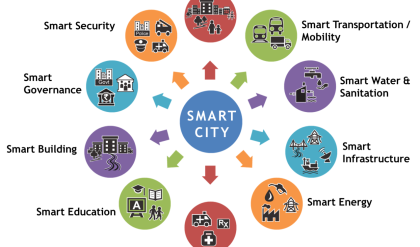
The Ultimate Guide to Smart Services: Choosing the Right Ones for You
In today’s hyper-connected world, “smart” isn’t just a buzzword; it’s a lifestyle. Smart homes, smart cars, smart assistants – the possibilities seem endless. But navigating the plethora of smart services available can feel overwhelming. This guide cuts through the noise, helping you identify the smart services that genuinely enhance your life, rather than just adding complexity.
Part 1: Understanding the Smart Services Landscape
Smart services leverage technology to automate tasks, improve efficiency, and offer personalized experiences. They range from the seemingly simple (smart lighting) to the incredibly sophisticated (AI-powered financial management). Before diving in, consider these key categories:
-
Home Automation: This encompasses smart lighting, thermostats, security systems, appliances, and entertainment systems, all controllable via smartphone or voice commands. Think seamless integration, energy efficiency, and increased security.
-
Personal Productivity: Smart assistants like Siri, Alexa, and Google Assistant streamline tasks like scheduling appointments, setting reminders, and managing emails. Other services might include smart note-taking apps, calendar synchronization tools, and personalized to-do lists.
-
Health & Wellness: Wearable fitness trackers, smart scales, and health monitoring apps provide data-driven insights into your well-being. These services can help you track your activity levels, sleep patterns, and even your mental health.
-
Entertainment & Media: Streaming services, smart TVs, and gaming consoles offer personalized entertainment experiences. Smart features include personalized recommendations, voice control, and seamless integration with other smart devices.
-
Financial Management: Budgeting apps, investment platforms, and AI-powered financial advisors help you manage your finances efficiently. These services offer features like automated savings, expense tracking, and personalized investment advice.
Part 2: Assessing Your Needs and Priorities
Choosing the right smart services hinges on understanding your individual needs and priorities. Ask yourself:
-
What are my pain points? Are you struggling with time management, energy bills, or home security? Smart services can address these directly.
-
What are my tech skills? Some services require a higher level of technical proficiency than others. Choose services that align with your comfort level.
-
What’s my budget? Smart services range in price from affordable to premium. Set a realistic budget and stick to it.
-
What are my privacy concerns? Consider the data collected by smart services and choose providers with strong privacy policies.
Part 3: Smart Service Selection: A Practical Guide
This table highlights some popular smart services across different categories, along with their key features and potential drawbacks:
| Category | Service Example | Key Features | Potential Drawbacks |
|---|---|---|---|
| Home Automation | Philips Hue Lighting | Customizable lighting scenes, voice control | Initial investment cost, potential glitches |
| Personal Productivity | Google Calendar | Scheduling, reminders, integration with other apps | Over-reliance on technology |
| Health & Wellness | Fitbit Charge 5 | Activity tracking, sleep monitoring, heart rate monitoring | Data accuracy, privacy concerns |
| Entertainment & Media | Netflix | Personalized recommendations, offline viewing | Subscription fees, content limitations |
| Financial Management | Mint | Budgeting, expense tracking, financial insights | Data security, reliance on algorithms |
Part 4: Integration and Interoperability
The beauty of smart services lies in their ability to work together seamlessly. Before investing in multiple services, ensure they are compatible with each other and your existing devices. Look for services that support popular protocols like Wi-Fi, Bluetooth, and Zigbee.
Part 5: Embracing the Smart Future Responsibly
While smart services offer incredible potential, it’s crucial to use them responsibly. Be mindful of your data privacy, regularly update your software, and remain aware of potential security vulnerabilities. Don’t let technology control you; rather, use it to enhance your life and achieve your goals.
By carefully considering your needs, understanding the available options, and prioritizing security and privacy, you can effectively harness the power of smart services to create a more efficient, comfortable, and fulfilling life. The smart future is within your reach – choose wisely.

Additional Information
Delving Deeper: An Analytical Exploration of Smart Service Selection
The concept of “smart services” – leveraging technology to enhance efficiency, personalization, and customer experience – is rapidly evolving. While a guide might outline basic selection criteria, a deeper dive is crucial for navigating this complex landscape. This analysis expands upon a hypothetical “Ultimate Guide to Smart Services,” providing critical insights to inform strategic decision-making.
Beyond the Surface: Unveiling Underlying Factors
A simple guide often focuses on surface-level features like user-friendliness and cost. However, successful smart service implementation hinges on deeper considerations:
-
Integration Capabilities: The guide should emphasize seamless integration with existing systems. A poorly integrated smart service can become a technological silo, hindering efficiency instead of boosting it. For example, a CRM system integrated with a smart chatbot can provide personalized customer support, but if the integration is flawed, it can lead to data inconsistencies and frustrated customers. The analysis needs to assess the API landscape, data transfer protocols, and potential security vulnerabilities associated with integration.
-
Scalability and Flexibility: The chosen service must adapt to growing business needs. A guide must analyze the scalability of the service’s infrastructure, its capacity to handle increased data volume and user traffic, and its ability to accommodate future feature expansions. For instance, a cloud-based solution generally offers better scalability than an on-premise system.
-
Data Security and Privacy: Smart services often handle sensitive customer data. The analysis needs to scrutinize the service provider’s security protocols, compliance with relevant regulations (GDPR, CCPA, etc.), and data encryption methods. A breach can have devastating consequences, both financially and reputationally. Examples of robust security measures, like multi-factor authentication and intrusion detection systems, should be detailed.
-
Vendor Lock-in: Choosing a proprietary service might offer initial advantages, but it could lead to vendor lock-in, limiting future flexibility and potentially increasing costs. The guide should assess the service’s openness, its adherence to open standards, and the feasibility of migrating to alternative providers.
-
Total Cost of Ownership (TCO): While upfront costs are important, the guide needs to emphasize the importance of calculating the TCO, considering factors like implementation costs, maintenance fees, training expenses, and ongoing support. A seemingly cheaper option might prove far more expensive in the long run.
Case Study Analysis: Illustrating Successful (and Unsuccessful) Implementations
Analyzing real-world examples provides crucial context. For example:
-
Successful Case: A major retailer integrating a smart inventory management system, resulting in reduced stockouts, optimized warehousing, and significant cost savings. This section should quantify the improvements—e.g., “reduced stockouts by 15%,” “improved inventory turnover by 10%,” etc.
-
Unsuccessful Case: A company implementing a sophisticated AI-powered customer service chatbot without adequately training staff, leading to customer frustration and a negative impact on brand perception. This analysis should highlight the key failure points—inadequate training, lack of human oversight, and failure to address the limitations of the technology.
Future Trends & Implications:
The guide should look beyond current offerings and explore emerging trends:
- AI-driven personalization: The increasing sophistication of AI will allow for even more personalized smart services.
- Edge computing: Processing data closer to the source will improve response times and reduce latency.
- The rise of serverless architectures: This approach offers greater scalability and cost-effectiveness.
Conclusion:
Choosing the right smart services requires a strategic, analytical approach that goes beyond superficial features. By considering factors like integration, scalability, security, and TCO, organizations can make informed decisions that lead to tangible benefits. A comprehensive guide should not only present options but also empower readers to critically evaluate them, fostering a deeper understanding of the implications of smart service adoption. The addition of detailed case studies, statistical analysis, and projections of future trends will elevate the guide from a basic overview to a valuable resource for strategic decision-making.





